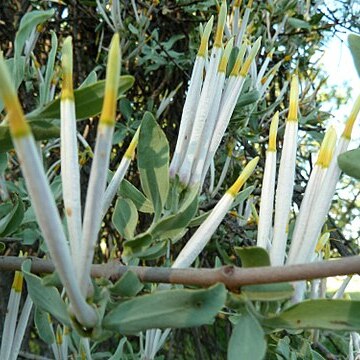Hemiparasitic shrub, 0.3-1.5 m high. Leaves opposite to alternate on long-shoots, crowded and smaller at base and tip of short-shoots, linear-elliptic, linear-lanceolate, oblanceolate or obovate-elliptic, acute, grey-green to glaucous, coriaceous, glabrous to densely puberulous, with 3 or 4 pairs of lateral veins, the lower ones strongly ascending. Flowers 3-6 at tips of short-shoots, occasionally in shortly pedunculate, axillary umbels, tubular, with a slight basal swelling, grey or white; lobes erect, banded yellow or orange with yellow-green to red apex; stamens red. Flowering time Sept.-Jan.
Leaves opposite to alternate on long shoots, crowded and smaller at base and tips of short shoots, deciduous; petiole 1–5 mm long; lamina coriaceous, grey-green to glaucous, 2–6 × 0.5–2 cm, linear-elliptic, linear-lanceolate, oblanceolate or obovate-elliptic, acute, obtuse or rounded at apex, narrowed at base, glabrous to densely puberulous, with 3–4 pairs of lateral nerves, the lower ones strongly ascending.
Flowers 3–6 at ends of short shoots, occasionally also in shortly pedunculate axillary umbels; short shoots 1–9 cm long; pedicels 7–10 mm long, glabrous to hispidulous; bracts with a triangular-ovate limb up to 12 mm long from a saucer-shaped base or sometimes larger, linear to foliaceous.
Corolla 5–8 cm long, grey or white, lobes banded yellow or orange with yellow-green to red tips, glabrous to hispidulous, apiculate at apex of buds, only slightly swollen at base; lobes erect, 14–22 mm long, the upper two-thirds to three-quarters linear-lanceolate, shiny inside.
Shrub extending to 1 m or more, flowering on short shoots; branchlets slightly compressed at first, glabrous to densely hispidulous with short spreading hairs.
Style swollen for 10–12 mm opposite filaments, with a neck 5.5–7.5 mm long above; stigma 0.5–1 mm across, capitate, ± bilobed.
Stamens red (at least basally); filaments inflexed, with a small ledge near apex inside; anthers 5–6.5 mm long.
Calyx 0.5–1 mm long, sinuate, ± split by expanding corolla.
Receptacle 2–3 mm long, glabrous to puberulous.
Berry red, 12–15 × 12–13 mm, globose-obovoid.

